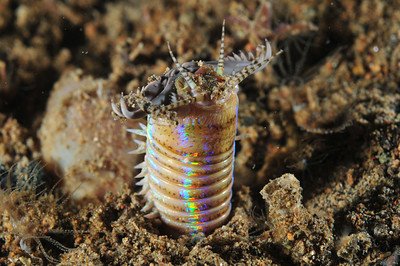
Now, let’s break this down. The Bobbit worm thrives in sandy or muddy substrates on the ocean floor. But it’s not just about where they live; it’s also about how they interact with their environment. Natural reef substrates are critical not just for the worms but for countless other marine organisms. Think of it as a bustling city, where all the residents—like the Bobbit worm—have specific roles in maintaining the ecosystem’s health. So, pour yourself a cup of coffee, and let’s explore the incredible world of Bobbit worms and their reef homes.
What Exactly Is a Bobbit Worm?
Bobbit worms, scientifically known as *Eunice aphroditois*, can be quite the spectacle. These marine annelids can grow up to 10 feet long, although most are shorter. They have a segmented body, usually sporting vibrant colors that make them stand out among the ocean floor’s muted tones. You might say they’re the ocean’s version of a hidden garden snake—startling yet mesmerizing.
These worms are primarily found in tropical and subtropical waters, often hiding in their burrows within natural reef substrates. What’s so interesting is how they’ve adapted to their environment. Their long bodies allow them to retreat quickly into their burrows when threatened. Imagine a magician disappearing just as the audience begins to notice—the Bobbit worm does just that with expert precision!
Habitat: Natural Reef Substrates Explained
Natural reef substrates refer to the materials that make up the ocean floor around coral reefs. This can include everything from sand and mud to rocks and fragments of coral. These substrates play a crucial role in supporting marine life, including organisms like the Bobbit worm, which rely on them for shelter and sustenance.
Here’s why these substrates matter: they provide a habitat for countless species, serve as a breeding ground, and even help in nutrient cycling. For Bobbit worms, this is critical. They burrow into these natural substrates, using their environment to catch prey. It’s like having a cozy home with room service—everything they need is right there!
The Role of Bobbit Worms in the Ecosystem
You might be wondering, why should we care about a creature that spends its days hidden away in the sand? Well, Bobbit worms play a significant role in their ecosystem. They are carnivorous, feeding on small fish and other marine organisms that wander too close to their burrows. When they strike, it’s both quick and efficient, showcasing their predatory prowess.
By controlling the populations of smaller fish and invertebrates, Bobbit worms help maintain the balance in their habitats. Think of them as nature’s pest controllers. Plus, their burrowing activity helps aerate the substrate, allowing oxygen to reach other organisms living in the sediment. This is essential for a healthy marine ecosystem.
Challenges Faced by Bobbit Worms
Like many marine creatures, Bobbit worms face challenges that threaten their populations. For instance, habitat destruction caused by pollution and climate change is a significant concern. Coral reefs are particularly vulnerable; when they suffer, so do the organisms that depend on them, including Bobbit worms.
Additionally, changes in water temperature and acidity can impact their reproduction and overall health. Imagine trying to thrive in an environment that keeps shifting beneath your feet—that’s the reality for these worms. Conservation efforts, like protecting reef habitats and reducing pollution, are crucial for ensuring that Bobbit worms and their ecosystems can continue to thrive.
Creating a Healthy Reef Environment
If we want to support Bobbit worms and similar marine life, thinking about reef health is crucial. This involves maintaining natural substrates and ensuring the surrounding waters are clean and well-balanced. Here are a few ways to help create a healthier reef environment:
- Reduce pollution: Limit waste and chemical runoff that can damage coral reefs and their inhabitants.
- Support reef protection initiatives: Get involved in local conservation efforts aimed at preserving marine ecosystems.
- Practice sustainable fishing: Overfishing can disrupt the balance of marine life, including Bobbit worms.
- Educate others: Share your knowledge about the importance of reefs and their creatures to foster a community focused on preservation.
Every small action contributes to the bigger picture of marine health.
Why Bobbit Worms Matter
So, why should we care about Bobbit worms and their natural reef substrates? The answer lies in the intricate web of life that connects all creatures in the ocean. Bobbit worms might seem insignificant, but they serve as a reminder of how every part of the ecosystem plays a role. By understanding their importance, we can better appreciate and protect our oceans.
Plus, they’re a fascinating example of the diversity of life under the sea. Their unique adaptations and behaviors inspire curiosity and learning about marine biology. By recognizing the value of every creature, big or small, we can help ensure a healthier planet for future generations.
Bobbit worms and natural reef substrates together create a vibrant and essential part of marine ecosystems. From their impressive hunting skills to their role in maintaining the balance of ocean life, these worms are much more than meets the eye. As we continue to learn about and appreciate these creatures, we also find ourselves drawn into the broader narrative of ocean conservation.
By understanding their habitat and the challenges they face, we can all play a role in protecting these fascinating worms and the reefs they call home. So the next time you think about the ocean, remember the hidden wonders like the Bobbit worm. They’re a vital part of our planet’s underwater tapestry, deserving of respect and protection.
